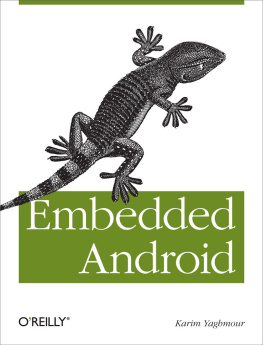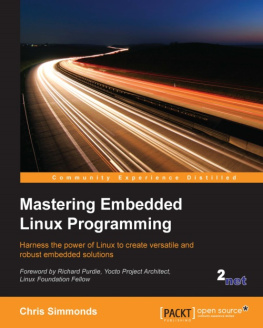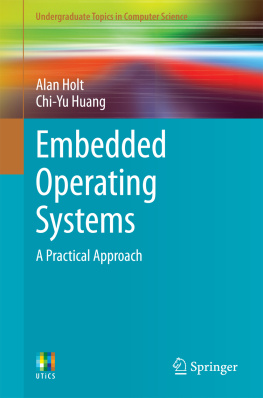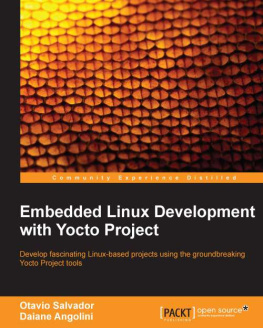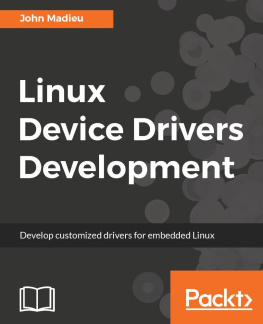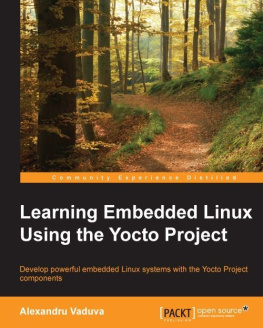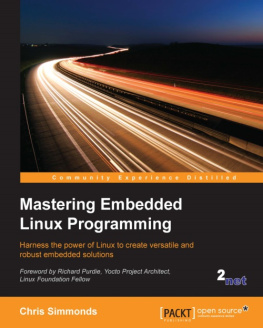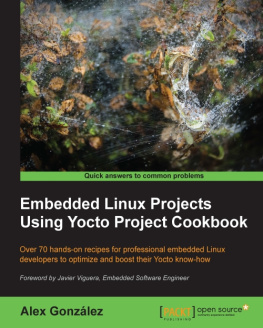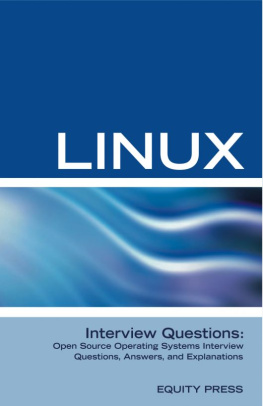Building Embedded Linux Systems
Karim Yaghmour
Jon Masters
Gilad Ben-Yossef
Philippe Gerum
Copyright 2009 Karim Yaghmour and Jon Masters
OReilly books may be purchased for educational, business, or sales promotional use. Online editions are also available for most titles (.
Nutshell Handbook, the Nutshell Handbook logo, and the OReilly logo are registered trademarks of OReilly Media, Inc. Building Embedded Linux Systems , the image of a windmill, and related trade dress are trademarks of OReilly Media, Inc.
Many of the designations used by manufacturers and sellers to distinguish their products are claimed as trademarks. Where those designations appear in this book, and OReilly Media, Inc. was aware of a trademark claim, the designations have been printed in caps or initial caps.
While every precaution has been taken in the preparation of this book, the publisher and authors assume no responsibility for errors or omissions, or for damages resulting from the use of the information contained herein.

O'Reilly Media
Preface
Jon Masters, Cambridge, Massachusetts
When the author of this books first edition, Karim Yaghmour, first suggested using Linux in an embedded system back in 1997 while working for a hardware manufacturer, his suggestion was met with a certain degree of skepticism and surprise. Today, Linux is either in use already or is being actively considered for most embedded systems. Indeed, many industry giants and government agencies are increasingly relying on Linux for their embedded software needs.
This book was very well received in its first edition, but a number of advances in the Linux kernel and accompanying tools since the books appearance make Linux even more attractive. Foremost among these are a number of real-time extensions and companion environments, some of which are discussed in the last three chapters of this edition.
Also, since the first edition of this book, enthusiastic open source and free software programmers have simplified the building and installation of GNU/Linux components (we use GNU here to acknowledge the centrality of tools from this free software project in creating functional Linux systems). This second edition therefore introduces you to a world of wonderful high-level tools, including Eclipse and various tools that build the build tools for embedded Linux systems. But we preserve much of the low-level information for those who need it, and to help you understand what the helper tools are doing behind the scenes.
In keeping with the explosions of progress on various parts of Linux and accompanying tools, its useful to get a variety of expert perspectives on topics in embedded and real-time Linux. Therefore, for the second edition of this book the authors are joined by a number of key participants in the GNU/Linux community, including those doing kernel development or creating related projects.
Focus on Self-Sufficiency
The widespread interest and enthusiasm generated by Linuxs successful use in a number of embedded applications has led to the creation of a plethora of articles, websites, companies, and documents all pertaining to embedded Linux. Yet, beyond the flashy announcements, the magazine articles, and the hundreds of projects and products that claim to ease Linuxs use in embedded systems, professional developers seeking a useful guide are still looking for answers to fundamental questions regarding the basic methods and techniques required to build embedded systems based on the Linux kernel.
Much of the documentation currently available relies heavily on the use of a number of prepackaged, ready-to-use cross-platform development tools and target binaries. Yet other documents cover only one very precise aspect of running Linux on an embedded target.
The first edition of this book was a radical departure from the existing documentation in that, other than your desire to use Linux, it makes no assumptions as to the tools you have at hand or the scope of your project. All that is required for this book is an Internet connection to download the necessary packages, browse specific online documentation, and benefit from other developers experiences, as well as share your own, through project mailing lists. You still need a development host and documentation regarding your targets hardware, but the explanations we outline do not require the purchasing of any product or service from any vendor.
Besides giving the greatest degree of freedom and control over your design, this approach is closest to that followed by the pioneers who have spearheaded the way for Linuxs use in embedded systems. In essence, these pioneers have pulled on Linux to fit their applications by stripping it down and customizing it to their purposes. Linuxs penetration of the embedded world contrasts, therefore, with the approach followed by many software vendors to push their products into new fields of applications. As an embedded system developer, you are likely to find Linux much easier to pull toward your design than to adapt the products being pushed by vendors to that same design.
This books approach is to allow you to pull Linux toward your design by providing all the details and discussing many of the corner cases encountered when using Linux in embedded systems. Although it is not possible to claim that this book covers all embedded designs, the resources provided here allow you to easily obtain the rest of the information required for you to customize and use Linux in your embedded system.
In writing this book, our intent was to bring the embedded system developers who use open source and free software in their designs closer to the developers who create and maintain these open source and free software packages. Though a lot of mainstream embedded system developersmany of whom are high-caliber programmersrely on third-party offerings for their embedded Linux needs, there is a clear opportunity for them to contribute to the open source and free software projects on which they rely. Ultimately, this sort of dynamic will ensure that Linux continues to be the best operating system choice for embedded systems.
Audience for This Book
This book is intended first and foremost for the experienced embedded system designer who wishes to use Linux in a current or future project. Such a reader is expected to be familiar with all the techniques and technologies used in developing embedded systems, such as cross-compiling, BDM or JTAG debugging, and the implications of dealing with immature or incomplete hardware. If you are such a reader, you may want to skip some of the background material about embedded system development presented early in some sections. There are, however, many early sections (particularly in ) that you will need to read, because they cover the special implications of using the Linux kernel in an embedded system.
This book is also intended for the beginning embedded system developer who would like to become familiar with the tools and techniques used in developing embedded systems based on Linux. This book is not an introduction to embedded systems, however, and you may need to research some of the issues discussed here in an introductory textbook.
If you are a power user or a system administrator already familiar with Linux, this book should help you produce highly customized Linux installations. If you find that distributions install too many packages for your liking, for example, and would like to build your own custom distribution from scratch, many parts of this book should come in handy, particularly .


